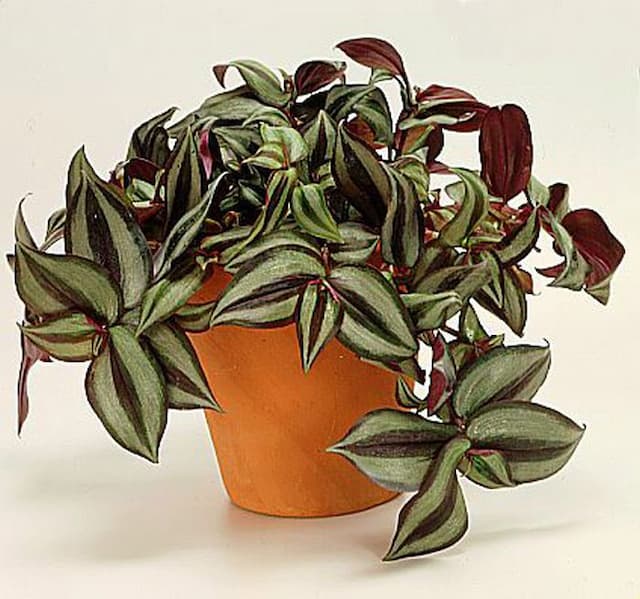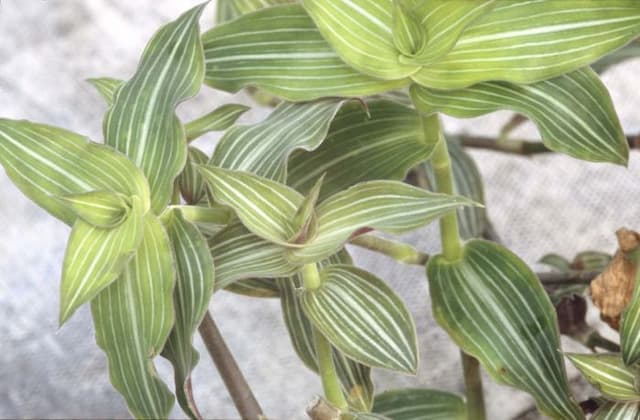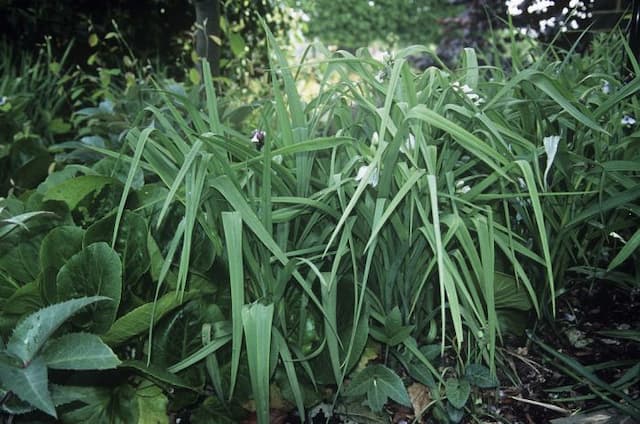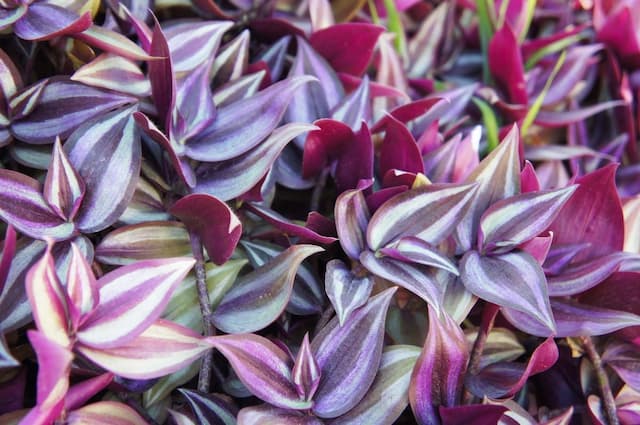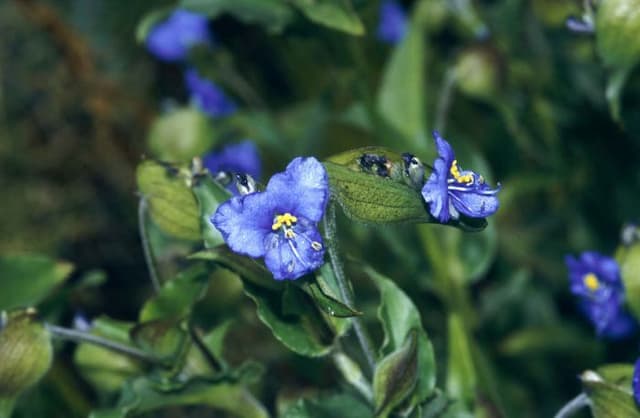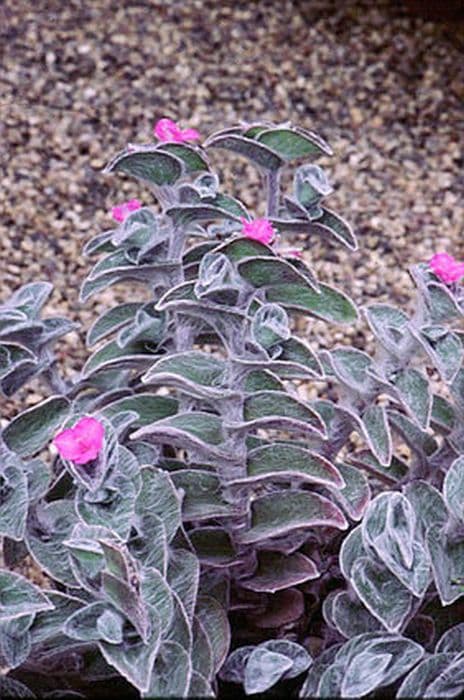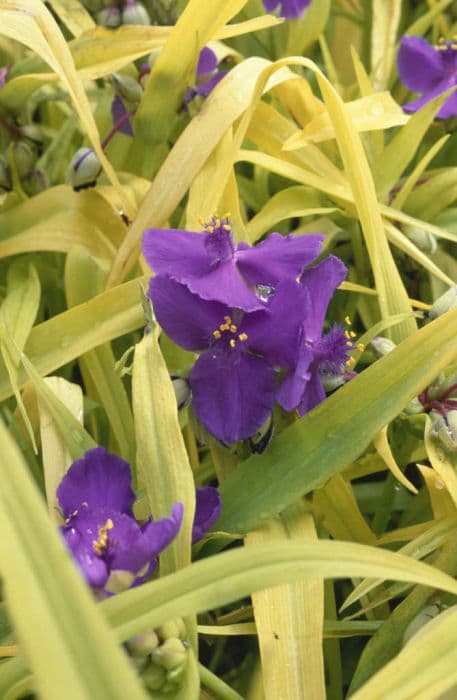Inch plant Tradescantia fluminensis 'Quicksilver' (v)

ABOUT
Tradescantia fluminensis 'Quicksilver', commonly known as inch plant, is a variegated cultivar that boasts an attractive foliage display. Its leaves are elongated and pointed, reminiscent of a lance shape, featuring a unique color pattern. The main body of the leaf is a pale green, accented with silvery-gray stripes running along the length. Along the perimeter, a delicate white margin outlines the leaf, giving it a distinct bordered look. Inch plant produces small, inconspicuous flowers that may appear throughout the year under the right growing conditions. These flowers are often a pale shade of purple or pink and present a trio of petals with a subtle, delicate texture. The leaves cascade gently from the stems, creating a lush, trailing effect that is often sought after for hanging baskets or as a spreading groundcover. The variegation on the foliage adds a pop of contrast and brightness to shaded areas or indoor spaces.
About this plant
 Names
NamesFamily
Commelinaceae.
Synonyms
Inch Plant, Wandering Jew, Small-Leaf Spiderwort, River Spiderwort, Creeper, Wandering Trad, Wandering Willie, Wandering Gypsy.
Common names
Tradescantia albiflora, Tradescantia fluminensis.
 Toxicity
ToxicityTo humans
The plant commonly known as inch plant is not considered highly toxic to humans. However, it may cause mild irritation to the skin or stomach if ingested. Usually, the plant is not a cause for concern when touched or accidentally consumed in small quantities, but larger amounts or sensitive individuals may experience symptoms such as nausea, vomiting, or diarrhea.
To pets
Inch plant can be mildly toxic to pets, such as cats and dogs. If a pet ingests parts of this plant, it could experience symptoms like vomiting, diarrhea, or skin irritation. While generally not life-threatening, ingesting this plant could still cause discomfort for your pet, and it is advisable to prevent pets from chewing on it.
 Characteristics
CharacteristicsLife cycle
Perennials
Foliage type
Evergreen
Color of leaves
Variegated
Flower color
White
Height
0.6 feet (0.2 meters)
Spread
1.5 feet (0.5 meters)
Plant type
Herb
Hardiness zones
9
Native area
South America
Benefits
 General Benefits
General Benefits- Easy maintenance: This plant is known for being low maintenance and easy to care for, which makes it ideal for beginners or those with a busy lifestyle.
- Fast growth: Tradescantia fluminensis 'Quicksilver' grows quickly, providing immediate gratification for gardeners and plant enthusiasts.
- Adaptability: It can adapt to various light conditions, although it thrives best in bright, indirect light.
- Propagation: Propagation is straightforward; stem cuttings root easily in water or soil, making it simple to create more plants.
- Attractive foliage: The 'Quicksilver' variety has distinctive variegated silver and green leaves that make it visually appealing as an ornamental plant.
- Versatility: It can be grown both as a ground cover in gardens or as a trailing plant in hanging baskets, adding to its versatile uses in landscaping and interior decor.
- Drought tolerance: Once established, it has a level of drought tolerance, which reduces the need for frequent watering.
 Medical Properties
Medical PropertiesThis plant is not used for medical purposes.
 Air-purifying Qualities
Air-purifying QualitiesThis plant is not specifically known for air purifying qualities.
 Other Uses
Other Uses- As a natural dye: The leaves of the Tradescantia fluminensis 'Quicksilver' can be boiled to produce a light green dye for fabrics.
- Photographic film: The sap contained in Tradescantia has been used in historical processes for developing photographic film due to its light sensitivity.
- Plant terrariums: This variety, with its variegated leaves, is popular for adding visual interest within enclosed glass terrariums.
- Educational tool: Sometimes used in classrooms to demonstrate plant propagation, as cuttings from this plant root easily.
- Indicator plant: Can serve as an indicator of poor air quality in an enclosed environment as it reacts to certain pollutants by displaying leaf spots.
- Art and crafts: The stems and leaves are used in decorative arrangements and as a natural element in various crafts.
- Living screens: When planted closely in outdoor gardens, this species can create a dense and attractive living screen for privacy.
- Livestock feed: In some cases, the plant has been used as fodder for certain types of livestock, although this is less common.
- Soil erosion control: Due to its quickly spreading nature, Tradescantia fluminensis 'Quicksilver' can help stabilize soil and prevent erosion.
- Fish tanks: Aquarium enthusiasts sometimes use T. fluminensis for aquascaping due to its tolerance for being partially submerged.
Interesting Facts
 Feng Shui
Feng ShuiThe Wandering Jew is not used in Feng Shui practice.
 Zodiac Sign Compitability
Zodiac Sign CompitabilityThe Wandering Jew is not used in astrology practice.
 Plant Symbolism
Plant Symbolism- Adaptability: The Tradescantia fluminensis, commonly known as the inch plant, has the ability to thrive in various light conditions, symbolizing the capacity to adjust and succeed in different environments.
- Growth and Vitality: Inch plants have a fast-growing nature, which is often associated with vitality and the rapid development of ideas or projects.
- Tenacity: Given its invasive tendencies when not managed properly, the inch plant can represent persistence and determination, as it is difficult to eradicate once established.
 Water
WaterThe Inch Plant should be watered regularly, ensuring the soil is kept moist but not waterlogged. Typically, watering once a week is enough, but during warmer months, you may need to water it twice a week. Provide the plant with approximately 8-16 ounces of water per session, depending on the size of the pot and the humidity level of the environment. It's important to reduce watering in the winter months when the plant is not actively growing. Test the soil moisture by touching it; if the top inch feels dry, it’s time to water.
 Light
LightInch Plant thrives in bright, indirect sunlight but can tolerate lower light conditions. The best spot for this plant is near an east or north-facing window where it receives some morning sun but is shielded from the harsh afternoon light. Direct sunlight should be avoided as it can scorch the leaves.
 Temperature
TemperatureInch Plant prefers temperatures between 55°F and 75°F, making it ideal for typical indoor conditions. It can survive minimum temperatures down to 50°F but should not be exposed to temperatures below that as it can cause harm to the plant. Avoid drafts, sudden temperature changes, and heating or cooling vents to maintain a consistent environment.
 Pruning
PruningInch Plant should be pruned to encourage bushier growth and to maintain its shape. Trim back leggy stems during the growing season, ideally in spring or early summer, to stimulate new growth. Pruning can be done every few months or as needed when you notice the plant becoming too long or unruly. Use clean, sharp scissors or pruning shears for a tidy cut.
 Cleaning
CleaningAs needed
 Soil
SoilThe Wandering Jew 'Quicksilver' thrives in a soil mix composed of peat, perlite, and pine bark in equal parts, providing good aeration and drainage. The ideal soil pH for this plant is slightly acidic to neutral, ranging from 6.0 to 7.0.
 Repotting
RepottingWandering Jew 'Quicksilver' plants should be repotted every 1-2 years or when they become root-bound, to ensure continued growth and health.
 Humidity & Misting
Humidity & MistingWandering Jew 'Quicksilver' prefers high humidity levels, ideally between 40-60%, to thrive, but can tolerate average indoor humidity.
 Suitable locations
Suitable locationsIndoor
Place in bright, indirect light and keep soil moist for best growth.
Outdoor
Grow in partial shade, shelter from harsh sun, and keep moist.
Hardiness zone
9-11 USDA
 Life cycle
Life cycleTradescantia fluminensis 'Quicksilver' commonly known as Wandering Jew or Inch Plant, begins its life cycle with seed germination, occurring under warm and moist conditions. After germination, seedlings establish themselves rapidly with roots and shoots emerging swiftly due to the plant's invasive nature. As it matures, the plant develops long, trailing stems with variegated leaves that can root at nodes when in contact with soil, a process known as vegetative propagation. The Wandering Jew enters its flowering stage under optimal light conditions, producing small, three-petaled white flowers, although this stage may be rarely observed in indoor settings. Once pollinated, the plant can set seed, but most often, reproduction continues via stem cuttings or fragmentation. Over time, it may become leggy and bare at the base, at which point gardeners typically prune or propagate top sections to rejuvenate growth and maintain a dense, lush appearance.
 Propogation
PropogationPropogation time
Spring-Summer
Propogation: Tradescantia fluminensis 'Quicksilver', commonly known as inch plant, is best propagated during the warmer months of spring and summer when the plant is actively growing. The most popular method of propagation for inch plant is through stem cuttings. To propagate, choose a healthy section of stem approximately 4 to 6 inches long, ensuring there are at least two or three leaf nodes present. Remove the leaves nearest to the bottom of the cutting to expose the nodes, as these will form the roots. The cutting can then be placed directly into moist potting soil or, for a higher success rate, into a glass of water until roots develop, which typically takes about 1 to 2 weeks (25 to 50 millimeters). Once rooted, the new plant can be transferred to soil where it will continue to grow and flourish.
